Great Wall of China
series of fortifications built along the historical border of China
The Great Wall of China (万里长城 wàn lǐ cháng chéng) is a series of walls that stretch from Liaoning through Hebei, Tianjin, Beijing, Inner Mongolia, Shanxi, Shaanxi, and Ningxia into Gansu within the country of China.
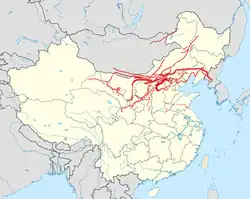
Understand
The Great Wall of China can be visited at many places along its length of several thousand kilometers. Its condition ranges from excellent to ruined and access varies from straightforward to quite difficult. Note that different sections also each have their own admission fees, e.g. if you want to hike from Jinshanling to Simatai then you probably have to pay twice. Although its construction is popularly associated with the tyrannical reign of the first emperor, Qin Shi Huang Di in the 2nd Century B.C., the wall that tourists see today dates much later to the Ming Dynasty.
History
The Great Wall, as we know it, is actually a series of several walls built at different times by different emperors.
- First Great wall: built by the Qin Dynasty 221–207 BC
- Second Great Wall: built by the Han Dynasty 205–127 BC
- Third Great Wall: built by the Jin Dynasty 1200 AD
- Fourth Great Wall: built by the Ming Dynasty 1367–1644
The other walls are now mostly ruins. It is the Ming wall that turns up in all the photos.
First Great Wall
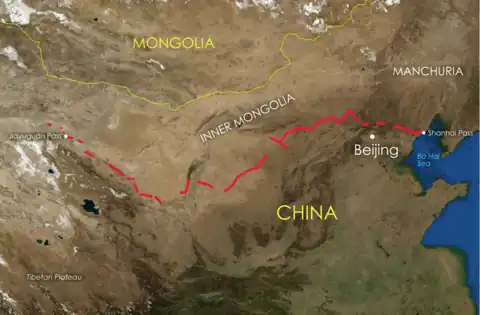
The First Great Wall was ordered built in 214 BC by Qin Shi Huang Di after he had finished consolidating his rule and creating a unified China for the first time. The wall was designed to stop raids by the nomadic Xiongnu raiders from the north. 500,000 laborers were used during the 32-year building period to create the First Great Wall.
Although the wall worked at keeping out enemies, it did nothing to stop internal pressures which lead to a regime change in 206 BC and the new leadership of the Han Dynasty. The first Han emperor, Gaozu, was quick to see the benefits of the wall against the raiders and ordered more wall to stretch out as far as Zhaoxiang, Gansu Province.
Second Great Wall
Over 70 years later, the Han Dynasty were still fighting the raiders since the Great Wall had been left to deteriorate and the raiders had breached it in several places. In 130 BC, Emperor Wu of the Han Dynasty embarked on a program of extending, rebuilding and fortifying the original First Great Wall. After the emperor finished adding more regions under his rule in 127 BC, he ordered a major expansion program that created the Second Great Wall, outposts in Zhangye, Wuwei, Jiuquan, Dunhuang and Yumenguan in Gansu Province and Lopnor and other outposts in Xinjiang Province. The Great Wall was extended down the Hexi Corridor through which the Silk Road traders would travel on the way to and from the West.
When the Han Dynasty fell apart into the three kingdoms of the Wei, Shu and Wu, the northern Wei kingdom decided to continue maintaining the Great Wall so that they could keep out the Rouran and Qidan nomads from the northern plains. Despite the constant maintenance, the Wall kept being breached by the Rouran nomads. Additional walls were built inside and outside of the Great Wall by the different kingdoms. Eventually the Wei kingdom was replaced by the Jin Dynasty (AD 266 - 420) following a coup by Sima Yan, one of Wei's court officials.
Nothing more was done to the Great Wall until the reign of the Liao and Song dynasties. The Liao Dynasty, ruled by an ethnic minority tribe known as the Khitans (Qidan (契丹) in Mandarin), controlled the north while the Song Dynasty controlled the south. The Liao were troubled mainly by a tribe in the northeast region of China called the Jurchen (known as Nüzhen (女真) in Mandarin) so they built defensive walls along the Heilong and Songhua rivers. These failed to stop the raiders from coming south.
Third Great Wall
- See also: Mongol Empire
In 1115, the Jurchens conquered northern China and established the Jin Dynasty, and since they were from the north themselves, understood that the Mongols were right behind them. The Jin emperor ordered the construction of a Third Great Wall to be built in Heilongjiang and Inner Mongolia. The walls built had the characteristics of having ditches running along the walls full length.
Despite the impressive fortifications built, the Mongols overthrew the Jin in 1276 and established the Yuan Dynasty. During the Yuan dynasty's rule, the Wall fell into deep disrepair and in 1368, the Chinese Ming Dynasty rose up from a peasant rebellion within and took control.
The Ming Dynasty, after getting rid of the Mongols, determined that they would never be taken again by outsiders. The first emperor of the Ming Dynasty, Hongwu, re-established manning of the Great Wall, fortresses and garrisons were built along the wall, and the fort at Jiayuguan was built in 1372 at the western end of the wall. The third Ming emperor, Yongle, turned his focus outward from the empire and sent out explorers and diplomats into the big, wide world. See Voyages of Zheng He.
Fourth Great Wall
It was not until the battle of Tumu against the Mongols that renewed interest in reinforcing the Great Wall occurred. Between 1569 and 1583, the best-known parts of the Great Wall were built, the Fourth Great Wall. The reinforced wall managed to repel the Mongols several times.
The regrouped Jurchens, who re-named themselves the Manchus, retook China in 1644 and formed the Qing Dynasty. From this point on, the Wall slowly started to fade away while stone and rocks were taken from the Wall for building projects and homes. The Cultural Revolution definitely took its toll out on the wall when local people and local governments were encouraged to help dismantle the Great Wall.
It was not until 1984 that Deng Xiaoping started a restoration and protection project of the Great Wall. In 1987, the Great Wall was declared a Cultural World Heritage Site by UNESCO.
Landscape
The geography of Northern China ranges from mountainous in northeast Liaoning and Hebei Provinces, through the grasslands of Ningxia, semi-arid desert of China's loess plateau, and borders the sand dunes of the Tengger desert of Inner Mongolia. It is the area around Hebei and Beijing that most people associate with the Great Wall, but most of the Great Wall lies in the desert regions of the country.
Flora and fauna
Chinese wildlife is diverse, considering all of the different habitats available along the length of the Great Wall. From the rare Siberian tiger in the northeast to the protected and rare Giant Panda, which lives in southern Gansu, Sichuan, and Shaanxi, you never know what you might see on a given day.
Wild mammals can be found in the north, such as the Manchurian weasel, brown and black bears, northern pika, and mandarin vole. Deer species include Sika deer, roe deer and the long-sought-after spotted deer, which has many uses in Chinese medicine.
The birds of the region include various pheasants, black grouse, pine grosbeak, various woodpeckers, mandarin duck, and the fairy pitta, a rare migratory bird. Cranes are especially revered in China. Common, demoiselle, white-naped, hooded, and red-crowned cranes all breed in China.
You can find many tonic plants along the Great Wall, such as the rare ginseng (Panax ginseng). Chinese medicine has had many thousands of years to discover and use these tonic plants for the benefit of mankind.
Climate
Northern China has all four seasons and they arrive with a vengeance. Summer and winter temperatures normally reach extremes of over 40 °C and –20 °C respectively.
Get in
See local articles for detailed transportation on getting to specific sections of the Great Wall. Rural Beijing, Yanqing District and Northern Suburbs has details on getting to sections in north Beijing.
See
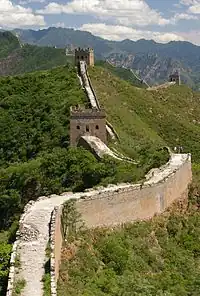
As the Great Wall of China is rather on the long side, there are a large number of places to visit it. The following list is divided by province/municipality.
Beijing
Find more detailed descriptions for each individual section in Northeastern Beijing, Yanqing District, Huairou District and Northern Suburbs.
- Badaling (八达岭 Bādálǐng) - The most popular tourist section in Beijing. It is well restored and super crowded. It takes ~2-3h to hike the whole wall depending on your fitness/weather/crowd.
- Shuiguan (水关 Shuǐguān) - Located near the Badaling Great Wall, Shuiguan is sometimes referred together as the 'Badaling-Shuiguan Great Wall'. It often happens that visitors are guided to the Shuiguan Great Wall rather than Badaling especially during holidays or peak periods.
- Juyongguan - Nearest section to the center of Beijing. Quite popular among tourists but nowhere near as crowded as Beijing. An expressway cuts through the section which does dampen the view.
- Mutianyu (慕田峪 Mùtiányù) - Magnificent and as equally well restored as Badaling. In comparison it is significantly less crowded than Badaling and has greener surroundings.
- Huanghuacheng (黄花城 Huánghuāchéng) - One of the most well built sections of the Great Wall - in fact it was so painstakingly built that the builder, Lord Cai, was beheaded for mismanagement and waste. This section is notable for its picturesque lakeside location.
- Simatai (司马台 Sīmǎtái) - Far off from central Beijing and in combination with the adjacent Gubei Watertown, a reconstructed historical town, has become a popular weekend travel destination for domestic and international tourists. Night tours overlooking the well illuminated Gubei Watertown are popular and tickets are sold separately.
- Gubeikou (古北口 Gǔběikǒu) - Also far from central Beijing than other sections but the extra time it takes to get there is rewarded with a very significant reduction in crowding and tourist traps.
- Jiankou - A section filled with landmarks and many pictures of the Great Wall are from this area. Famous structures including the Beijing Knot, a meeting point for three walls coming from different directions.
Hebei and Tianjin
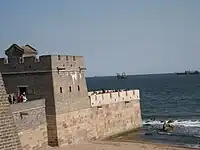
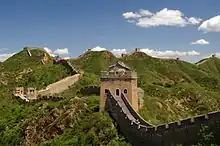
- Jinshanling (金山岭 Jīnshānlǐng) - The closest section in Hebei to Beijing.
- Shanhaiguan - at the Old Dragon's Head, the wall juts out into the sea. To get there from Beijing takes about 3 hours by train.
- Panjiakou Reservoir - sunken part of the Great Wall
- Huangyaguan - worth a visit for its water run-off controls, well-preserved towers, challenging hiking and striking scenery
- Wulonggou - A well-preserved section of the Great Wall in Laiyuan County. It is noteworthy for the high density of watchtowers. Due to the area's remote location, no restoration work has been carried out and there is relatively little in terms of tourist infrastructure. There are also no crowds or fees to contend with.
Liaoning
- Hushan - can be explored from Dandong
- Xingcheng - a Ming dynasty walled town
- Jiumenkou - located 18 km east of "The First Pass Under Heaven' at Shanhaiguan. There you can see the only existing Great Wall section above water, as well as a Great Wall tunnel within the mountain.
Shanxi
- The Outer Wall of Shanxi - Li'erkou to Deshengbu, Juqiangbu to Laoniuwan, and along the Yellow River
- The Inner Wall of Shanxi - Yanmenguan, Guangwu Old City, Ningwu Pass and Niangziguan
Shaanxi
Ningxia
- The Eastern Ningxia Wall - Hongshan Castle and Water Cave Gully (Shui Dong Gou)
- The Northern Ningxia Wall - in the area of Helanshan
- The Western Ningxia Wall - Zhenbeibu and Sanguankou
Gansu
Do
- Hike the wild wall. Make seeing the Great Wall a personal experience by hiking an unrestored or wild section where tranquility and isolation can be found. Popular hiking routes in Beijing can be found in the Do section at Rural Beijing. (updated Sep 2019)
Sleep
If you want to go on a multi-day trek over a wild section or just see the sunset, you can sleep in the towers with a sleeping bag and mat. Not on tourist sections, only wild ones of course. But please make sure to leave everything clean and take your trash with you.
Stay safe
Bring a jacket against the wind or cold in the chillier seasons. In winter, expect to lose 5 °C between Beijing and the Wall. This, plus the wind from the mountain, will make you cherish every layer of clothes you have. The vendors will be here to sell everything you may have forgotten, although the price is not reasonable. But the crowd is much lighter in winter, with almost nobody after the first peak. The winter sun and, if you're lucky, the snow will give you amazing views on the walls.In summer you will need lots of water, but there are plenty of vendors at the most visited sections. Be prepared for the possibility of sudden, short, but rather violent thunderstorms.
Do not leave any trace of your visit. Even if it is not an uncommon sight, resist the urge to add your name to the carvings in the wall, or take a piece home as a souvenir. If the wall should be damaged by your actions, the authorities may very well take action with fines and other punishments.
Hiking as a recreational sport is not well understood so the etiquette of crossing state and private land has not yet been established. Remember that the Wall is mostly mud and poorly supported stones, and that you are on your own if you're outside the maintained areas. Even if you are not walking on the wall, you will find few trails to follow and at some parts, the area the Wall traverses are vertical, treacherous and very unsafe. Besides that, it is difficult to obtain clean drinking water and some areas may even have no water at all. Other areas will have manmade obstacles, like roads and motorways that have solid fencing. Villages where you could get supplies may be few and far between. Some may take you miles away from the Wall. Poor cartography is still a problem here since maps of less than 1:450,000 are not easy to get a hold of due to the military applications of such maps. Besides that, guides who know the areas along the Great Wall are few and far between.
Beware of bus scams that may ruin your day. Also try to avoid organized tours to the Great Wall costing ¥100-150. These are advertised by people handing out flyers around the Forbidden City in Beijing for example (the real bus service to the Great Wall only costs ¥20!). Also, the driver might just stop and set you off before your destination.
Go next
Wikivoyage: Latitude 40.67693, Longitude 117.23193 (Map, Geohack)
Wikidata: Latitude 40.417, Longitude 116.083 (Map, Geohack)
Difference: 101.3km